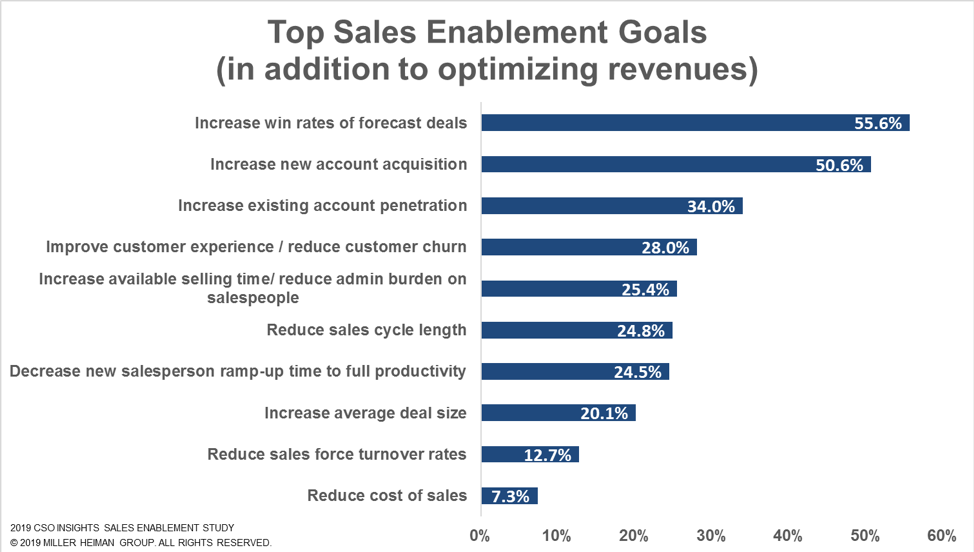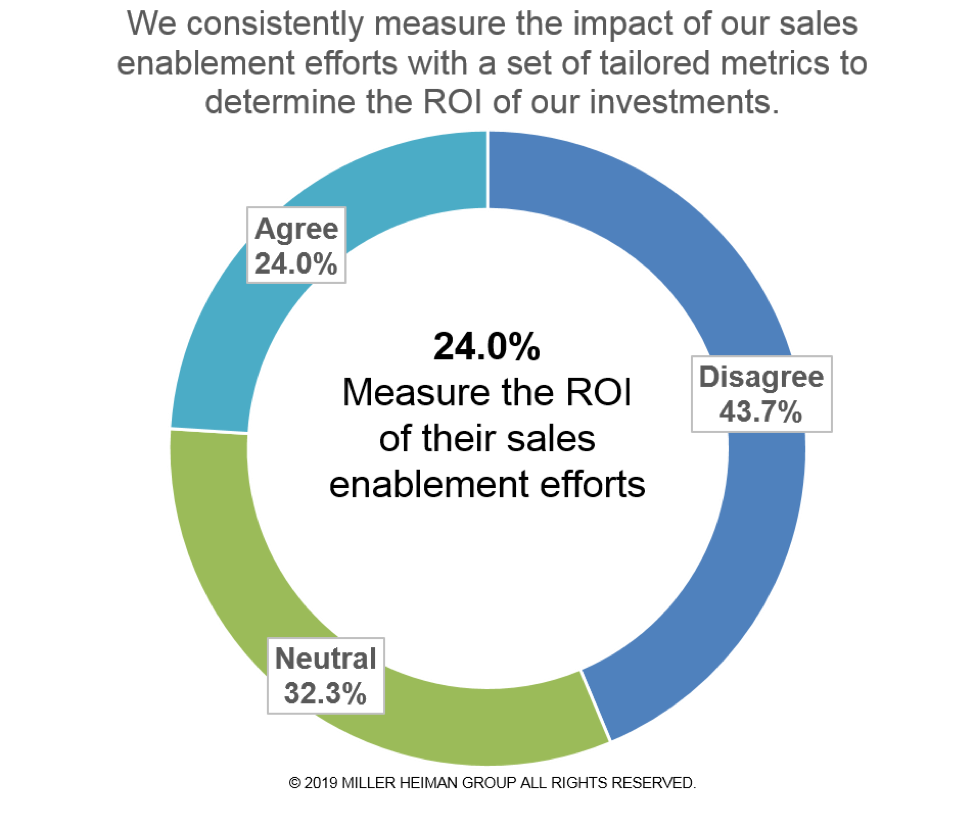A sales enablement trend we see year after year makes one thing perfectly clear: How sales enablement is set up makes all the difference in whether it has a positive impact on your organization. In fact, according to our 5th Annual Sales Enablement Study, the 15.8% of organizations that follow a strategic, formal charter-based approach to sales enablement enjoy win rates of 55.1%, compared to win rates of 39.2% for those that follow a random one-off project approach.
Looking at these results, it’s evident that shoring up a shaky sales enablement foundation is a worthy investment of both time and money. A formal charter-based approach also is a mandatory foundation to ensure most other sales enablement facets can be effective. In our 5th Annual Sales Enablement Study, we refer many times to the positive impact of such a foundation as one of the critical success factors that sets winners apart.
Today let’s look at the goals sales enablement teams focus on and how they measure success. Let’s also look at the impact a solid, formal charter-based approach has when it comes to setting up the right metrics.
In addition to optimizing revenue, sales enablement teams focus on a combination of effectiveness and efficiency goals.

Which KPIs does sales enablement use to measure progress toward these goals?
This question is often underestimated or treated as an afterthought. Most sales enablement teams, three-quarters to be precise, have no plan or strategy for how to measure the impact of their efforts. Imagine a business function or initiative that’s investing money, time and resources but lacks an approach for how to measure its impact. How long until the finance department shows up asking tough questions? They will… sooner rather than later. So it’s not a good idea to remain in that spot. For sales enablement, it’s about time to change that.
Sales enablement teams require an integrated context-based approach to measure the business impact of their efforts. But so far, only one-quarter does that.

We asked this question for the second year in a row and got very similar results. Only 24.0% measure the ROI of their enablement efforts, 29.0% measure milestones and productivity, and only 25.7% use both leading and lagging indicators. Why are so many sales enablement teams struggling when it comes to measuring their business impact?
Metrics need context to make sense. And metrics can only be purposefully tailored if a sales enablement strategy exists in the first place.
The lack of a well-thought-out sales enablement strategy and all of the related homework that needs to be done is the main reason for the lack of a purposeful approach to metrics. Only with such a clearly defined sales enablement strategy is it possible to connect related metrics to that strategy to measure both progress and impact. Depending on the maturity level and nature of the sales enablement strategy, milestones, productivity and performance metrics as well as leading and lagging indicators can be applied.
Organizations that follow a formal charter-based approach to sales enablement are 11 times more likely to measure the ROI of their enablement efforts than those with a random approach.
Let’s look at the 15.8% of organizations that follow a formal charter-based approach to sales enablement. We discussed the impact here in the beginning and in more detail here. If we look at this group, 50.5% of them were able to create a tailored metrics approach to determine the ROI of their enablement investments, compared to only 4.5% of those that followed a random one-off project approach. On average, 24.0% of organizations were able to measure the ROI of their enablement efforts.

Here are four steps sales enablement leaders can follow to close the metrics gap:
Ideally, you do all of the work that needs to be done to develop a formal sales enablement strategy with a charter. Then the metrics approach is part of that process. If you’re not there yet, at least get clarity on the next pilot you’re going to implement.
#1: Get clarity on the goals you must achieve.
That’s usually easier said than done, because a goal in this context is not to roll out a program or implement technology. A goal in this context is a metric that’s related to such an initiative that tells you whether the initiative was successful or not. To get there, always ask this question: What’s the business problem we have to solve? How is it measured?
#2: Assess the current state and develop a strategy.
You must assess your point of departure to be able to develop a tailored strategy. For example, if you have no process clarity in the organization, methodology training won’t solve your problem. You need a combined approach that not only looks at the why and how of these activities but also looks at the process (the sequence of activities). If your content is lacking, even the latest and best sales enablement content technology won’t solve the problem. In fact, it likely will make the problem even more visible. In that case, the content and messaging work would need to be done first.
#3: Connect relevant metrics to the strategy.
Now you can think about the relevant metrics that would be impacted by your initiative. For instance, if you run a new value messaging initiative along the customer’s path to improve the average deal size and get the average deal cycle down, you may want to look at conversion rates as a leading indicator first. You also may want to look at value, volume and velocity for each stage of your internal selling process chain. This way, you know the impact and progress you make (or not). As these are leading indicators, there’s enough time to investigate and adjust the approach. You always have an early warning system and a great tool to keep your senior executive sponsors engaged, informed and connected. And then you can measure the relevant lagging indicators, too.
#4: Learn from the pilot and initiative metrics and create an overall dashboard.
Based on your experience with the metrics on the single initiatives or pilots, you may want to collect the lessons learned and create a dashboard designed to determine the overall ROI of your sales enablement investments. To do that, I highly recommend doing the rest of the homework and creating your sales enablement charter or business plan.
Effective sales enablement leaders know how important it is to be able to determine the ROI of their efforts; therefore, they make the relevant metrics to be achieved (i.e., stakeholders’ expectations to be met) a priority rather than an afterthought.






